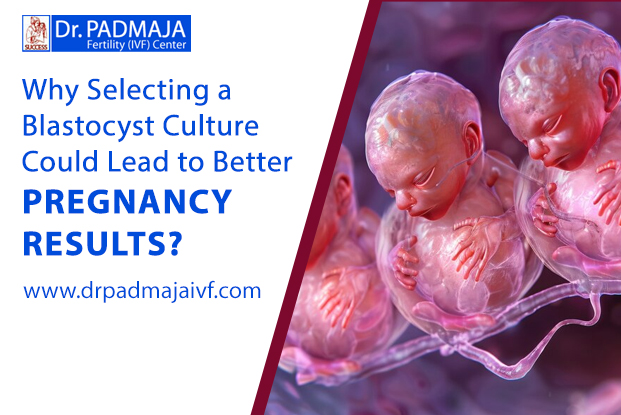When it comes to in vitro fertilization (IVF), couples are often overwhelmed with choices and options. Among these choices is the decision to culture embryos to the blastocyst stage. This stage, which occurs approximately five days after fertilization, offers unique advantages that can significantly enhance the chances of a successful pregnancy. If you’re considering IVF, especially at one of the best IVF centers in Hyderabad, such as Dr. Padmaja IVF Center, understanding the benefits of blastocyst culture is essential.
What is Blastocyst Culture?
Blastocyst culture refers to the process of allowing embryos to develop for five to six days after fertilization until they reach the blastocyst stage. During this time, the embryo undergoes crucial cell divisions and differentiations that prepare it for implantation in the uterine lining. The blastocyst stage is characterized by a fluid-filled cavity and the formation of two distinct cell types: the inner cell mass, which will develop into the fetus, and the trophoblast, which will form the placenta.
Improved Selection of Viable Embryos
One of the primary reasons to select blastocyst culture is the improved ability to select viable embryos. In a typical IVF cycle, several embryos are created, but not all of them have the potential to develop into a successful pregnancy. By extending the culture to the blastocyst stage, embryologists can better assess the quality of each embryo. The best IVF centers in Hyderabad, including the renowned Dr. Padmaja Fertility Center, utilize advanced techniques to identify the healthiest embryos, increasing the likelihood of a successful implantation.
Enhanced Implantation Rates
Studies have shown that embryos that reach the blastocyst stage tend to have higher implantation rates compared to those transferred at the cleavage stage (typically day 3). The advanced development of blastocysts means they are better equipped to adhere to the uterine lining, which is crucial for successful implantation. This improvement in implantation rates can be a game-changer for couples struggling with infertility.
Synchronization with Endometrial Development
Timing is critical in IVF, and the blastocyst culture stage often aligns better with the natural development of the endometrium (the uterine lining). By waiting until day 5 or 6 to transfer embryos, the embryo and endometrium are more likely to be synchronized, further enhancing the chances of successful implantation. This synchronized approach is one of the reasons why many patients choose Dr. Padmaja IVF Center, known for its personalized treatment plans and success rates.
Reduced Multiple Pregnancies
Another significant advantage of blastocyst culture is the reduced risk of multiple pregnancies. In traditional IVF, more embryos are often transferred to increase the likelihood of success, which can lead to higher chances of twins or higher-order multiples. By focusing on the best quality blastocysts, clinicians can often achieve pregnancy with fewer embryos, reducing the associated risks of multiple gestations for both the mother and the babies. At Dr. Padmaja Fertility Center, the emphasis is on achieving healthy pregnancies while minimizing risks.
Greater Success Rates
The ultimate goal of any fertility treatment is to achieve a successful pregnancy and healthy baby. Studies consistently show that utilizing blastocyst culture can lead to higher success rates in IVF cycles. Clinics like Dr. Padmaja IVF Center have seen impressive outcomes thanks to their commitment to advanced reproductive technologies, including blastocyst culture.
Emotional and Psychological Benefits
The journey of IVF can be emotionally taxing for couples. The knowledge that embryos are being carefully selected for their viability can provide peace of mind. Patients at top IVF centers, such as Dr. Padmaja Fertility Center, often report feeling more confident in their treatment plans, knowing that the medical team is utilizing the best possible methods to achieve pregnancy.
Conclusion
Choosing to culture embryos to the blastocyst stage is a significant decision that can profoundly impact IVF success rates. With better embryo selection, enhanced implantation rates, synchronization with endometrial development, reduced risks of multiple pregnancies, and overall higher success rates, it’s clear why many couples opt for this approach.
If you are considering IVF and want to explore your options further, visiting one of the best IVF centers in Hyderabad, like Dr. Padmaja IVF Center, can provide you with the guidance and expertise needed to navigate your fertility journey. With a focus on individualized care and state-of-the-art reproductive technologies, Dr. Padmaja Fertility Center is committed to helping couples achieve their dreams of parenthood.
Choosing blastocyst culture could be the key to unlocking a successful pregnancy. With the right support and the best practices in place, your journey to parenthood can be a hopeful and rewarding experience.
About The Author :

If Dr. Padmaja Divakar is a public figure or a professional in a specific field, I recommend checking her official website, professional profiles, or reliable online sources for the most up-to-date and accurate information about her background, qualifications, and achievements.
Frequently Asked Questions (faqs)
1.What is blastocyst culture?
Blastocyst culture involves allowing embryos to develop for five to six days after fertilization, reaching the blastocyst stage before being transferred into the uterus. This stage features a fluid-filled cavity and distinct cell types that are crucial for implantation.
2.How does blastocyst culture improve embryo selection?
By culturing embryos to the blastocyst stage, embryologists can better assess their quality and viability. This process helps in selecting the healthiest embryos, which can lead to higher success rates in implantation and pregnancy.
3.What are the benefits of higher implantation rates?
Embryos at the blastocyst stage have been shown to have higher implantation rates compared to those transferred earlier. This means they are more likely to successfully attach to the uterine lining, which is essential for establishing a pregnancy.
4.How does blastocyst culture align with endometrial development?
Blastocyst culture often synchronizes better with the natural growth of the uterine lining. By transferring embryos at day 5 or 6, the timing is more conducive for successful implantation, increasing the likelihood of pregnancy.
5.Does blastocyst culture reduce the risk of multiple pregnancies?
Yes, by focusing on transferring fewer, higher-quality embryos (i.e., blastocysts), the risk of multiple pregnancies, such as twins or triplets, can be minimized. This approach is safer for both the mother and the babies.

